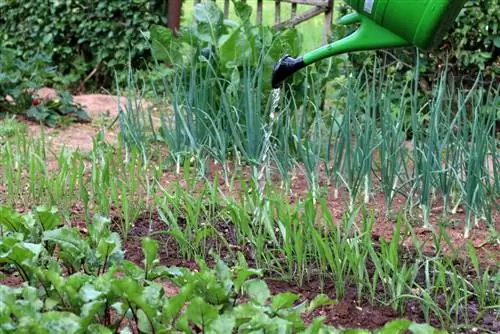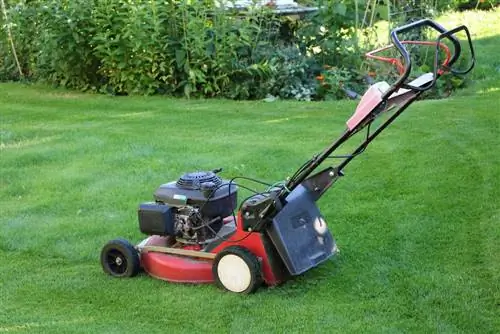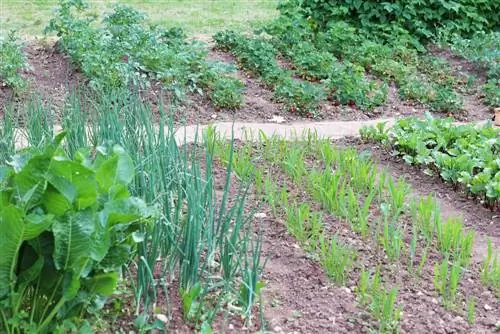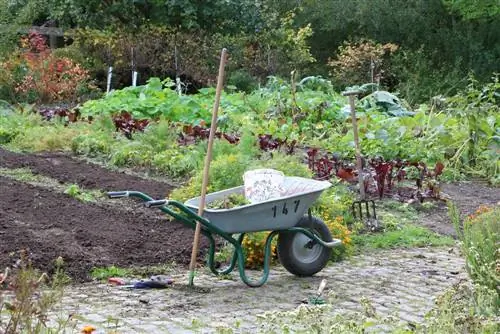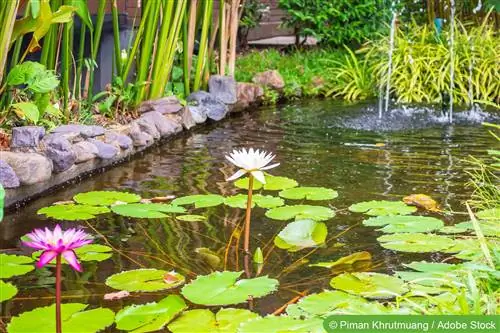- Author admin [email protected].
- Public 2023-12-17 03:39.
- Last modified 2025-06-01 06:48.
With a self-sufficiency garden, food scandals and food contaminated with pesticides become less of a threat. In order to fully regain responsibility for your diet over time, having your own vegetable garden is an important first step. Careful planning effectively prevents discouraging failures. This guide illuminates all the steps to your first small self-sufficient garden, from A, such as acreage, to Z, such as fencing. How to plan your vegetable garden with expertise.
Cultivated area - empirical values as a planning approach
There is no general rule of thumb available to determine the correct size of the cultivated area. Rather, your individual wishes and requirements determine the size of your first small self-sufficient garden. To get started, it is completely sufficient if the cultivated area ensures partial or largely self-sufficiency for your family. Once a sufficient we alth of experience has been accumulated, the step towards complete self-sufficiency no longer requires any gardening efforts. The following information serves as a guide for a practical planning approach for your vegetable garden:
- Partially self-catering: 25 m² per person
- Extensive self-sufficiency: 70 m² per person
- Full self-catering: 170 m² per person
This area information includes the cultivation of vegetables and herbs as well as the space required for work routes and compost areas. As part of complete self-sufficiency, growing areas for soft fruit are also planned.
Site conditions
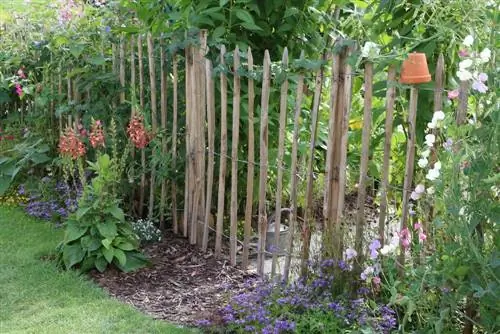
Once you have discovered an area with the recommended dimensions, carefully examine the light, temperature and soil conditions. The ideal location for a vegetable garden has these characteristics:
- Sunny to semi-shady location
- Protected from strong winds but still airy
- Preferably in the immediate vicinity of the house
- Loose, nutrient-rich soil, sandy-loamy with a small amount of clay
- Structurally stable, yet permeable soil
- Fresh to moist, without tendency to waterlogging
If the soil quality does not meet ideal conditions, compensate for minor deficits with soil additives. If the soil is too sandy, you can use compost, leaf mold or bark humus to improve its storage capacity for water and nutrients. Compacted soil becomes nice and loose and more permeable if you incorporate quartz sand or fine grit. If you are struggling with excessive exposure to wind, create a wind-protected microclimate with a hedge of shrubs as an enclosure.
Arrangement of the beds - farm garden with role model function
So that you can make an informed decision about the correct arrangement of the beds, please take a piece of paper. Sketch the available garden space to scale, with notes on local soil and lighting conditions. When planning your first small self-sufficiency vegetable garden, we recommend relying on the historical experience of farm and monastery gardens. Based on this know-how, you will develop your individual garden concept over the years. This arrangement of the beds has been proven in practice for centuries for profitable vegetable cultivation:
- 4 rectangular beds with a practical width of 1.20 m
- The length is tailored to the total area available
- Crossroads and a surrounding path as access to the beds
You can create a structured appearance with borders for each bed and a fence to enclose the entire vegetable garden. You can use this floor plan again later to create the planting plan.
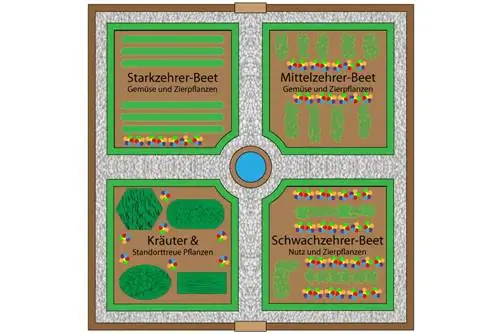
Tip:
The planning for your first small self-sufficient garden is only complete with a compost heap and a rain barrel or a water connection. Since water and nutrient supply is the linchpin of the care program, liquid water and organic fertilizer should always be within easy reach.
Path planning - basis for efficient work
Unhindered, dry access to the beds in any weather is a basic requirement for the smooth running of planting and care work in the vegetable garden. The width of the paths is such that you can easily maneuver with a wheelbarrow. Therefore, plan a width of 80 to 100 cm for each path. If it is already clear in advance that two people will always look after the self-catering garden at the same time, we recommend a path width of 150 cm. A wide range of suitable materials is available for covering:
- Bark mulch and sawdust: close to nature, suppresses weeds, must be replenished regularly
- Wooden discs laid in sand, gravel or earth: Own production and installation possible, but slippery when wet
- Clover: is sown every year, clippings serve as mulching material, allowing rainwater to seep away quickly
- Lawn: permanent, decorative path surface, must be mowed and trimmed regularly
- Sand and gravel: Not recommended for small vegetable gardens due to the high maintenance effort
Paths made of natural stone slabs are demanding to create. Once the initial effort has been overcome, these coverings will last for many years without the need for regular, time-consuming maintenance work. In the ecologically managed vegetable garden, weeds are allowed to grow between the plates, which underlines the natural character.
Bed borders
By edging each bed, you emphasize a well-groomed appearance and promote the local microclimate for your vegetable plants. A variety of decorative options leave plenty of scope for your personal taste. The following recommendations may serve as your inspiration:
- Wooden boards or mini palisades: stable, durable and easy to maintain
- Clinker or field stone: Massive demarcation, but expensive to purchase
- Small trees and perennials: true to nature, harmonize well with vegetable plants, require regular care
In classic cottage gardens, small book trees traditionally served as borders for vegetable beds. Since the increased appearance of the boxwood borer and shoot dieback, other plants have taken over this function. Low-maintenance species such as evergreen mountain ilex (Ilex crenata), dwarf privet (Ligustrum vulgare), fragrant lavender (Lavender officinalis) or the enchanting dwarf strawflower shrub (Helichrysum italicum) are very popular for the first small self-sufficient garden.
Enclosing a vegetable garden - tips for the ideal fence
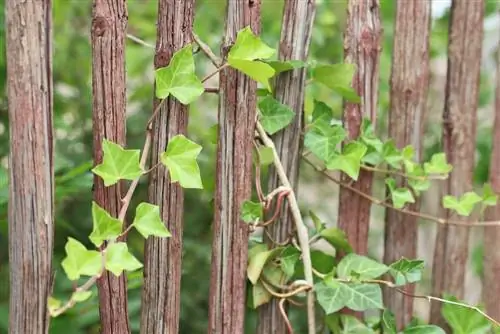
With a fence you can visually demarcate your vegetable garden and keep uninvited guests away. Even if your small self-catering garden is located within an already fenced area, we recommend fencing, which in this case can be lower. The following tips show the wide range of attractive and practical fences:
- Wooden fence made of spruce or larch slats and oak corner posts, 120-150 cm high
- Willow fence made of willow branches or hazelnut branches between vertical posts
- Picket fence, hunting fence made of larch slats between oak posts with ash clasps
- Living fence in the form of a hedge made of evergreen and/or deciduous shrubs
You can add picturesque accents to a simple wooden fence with flowering fence peepers. Sunflowers (Helianthus), clematis (Clematis) and hollyhocks (Alcea) come into their own here.
Tip:
Some space problems are solved with a vertical bed. Fences, pergolas or house walls are transformed into a space-saving cultivation area. Specialist retailers offer a variety of sophisticated, weatherproof planting systems. The selection extends from plant bags to head-high, vertical raised beds.
Mixed culture - ideal planting system in the vegetable patch
As a planting system for your first small self-sufficient garden, we would like to recommend the tried and tested mixed culture within the individual beds. This term describes the cultivation of different crops with similar nutritional requirements in the immediate vicinity on the same bed. Because heavy, medium and low feeders change the bed every year as part of the crop rotation, the soil is not depleted and no pathogens can accumulate. The aim of this method of cultivation is the targeted prevention of soil fatigue, diseases and pests.
The following examples illustrate the procedure for effective planting planning within the individual beds: If onions and carrots share the bed, onions repel the carrot fly. Cabbage and celery are a dream team because they protect each other from cabbage white and celery rust. If you add radishes to salad, cunning flea beetles have no chance. Mixed culture after root growth is also advantageous.
Deep-rooted plants such as beans, pumpkin or savoy cabbage harmonize wonderfully with shallow-rooted plants such as peas, spinach or lamb's lettuce because their roots do not get in each other's way. Of course, there are also neighbors who hinder each other's growth and yield in the vegetable patch. In expert mixed cultivation, peas are therefore not planted next to beans or tomatoes in the immediate vicinity of potatoes.
Plan the crop rotation of heavy and weak feeders correctly
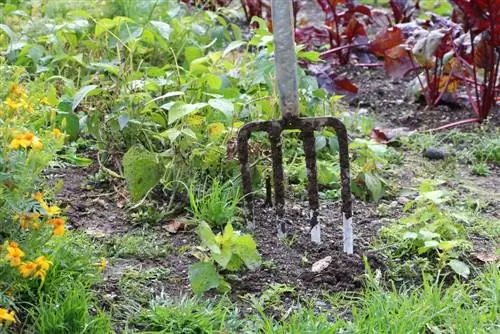
Within each bed, the mixed culture guarantees the best harvest results for the current season. By also taking into account the tried and tested crop rotation from year to year, you are making a further contribution to preventing soil fatigue, diseases and pests. For this purpose, in the first year, plant bed 1 with heavy feeders, bed 2 with medium feeders and bed 3 with low-feeding vegetable plants. The following year, bed 3 accommodates the heavy feeders, bed 2 accommodates the weak feeders and bed 1 accommodates the medium-feeding plants. If you continue with this change, you will rarely have to complain about diseases, pests or poor harvests in your first vegetable garden.
- Heavy eaters: Celery, all types of cabbage, pumpkin, tomatoes, zucchini and potatoes
- Medium eaters: Runner beans, onions, leeks, peppers and chard
- Weak eaters: Peas, carrots, French beans and most herbs
If you have included a fourth bed in the floor plan, perennial, site-specific vegetable plants, such as rhubarb, will thrive here. A niche should also be planned here for nettles and comfrey in order to produce rich, organic fertilizer in the form of plant manure from these plants.
The art of professional planning lies in sensibly combining mixed culture and crop rotation. Plants with the same nutrient requirements are not always suitable as bed neighbors. The association of peas and beans is a typical example of an unfavorable mixed culture, even though they are both weak eaters.
Tip:
Mix flowers with the vegetables, not only improve the appearance. With the right combination of ornamental and useful plants, you can optimize your defenses against diseases and pests. Marigolds and marigolds have been proven to repel lice, nematodes and viruses.
Conclusion
With the planning of the first vegetable garden, the dream of a self-sufficient garden is within reach. Even an area of 25 square meters per person is enough to regularly enjoy fresh, home-grown vegetables. Four beds of the same size with a crossroads and an enclosure give structure and form to the first step towards self-sufficient living. If you plan to plant a mixed culture with annual crop rotation, the soil life remains active and pathogens have a bad chance. If your debut is successful, you will gain valuable experience in organic vegetable cultivation over the years for completely independent self-sufficiency.

